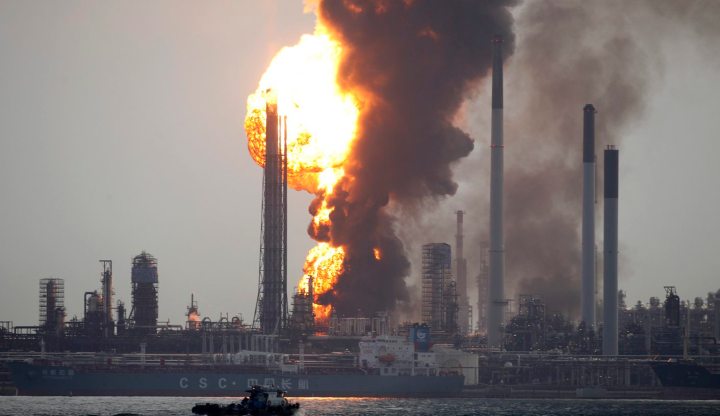Newsdeck
Shell To Develop World’s Deepest Offshore Oil Platform

Royal Dutch/Shell said on Wednesday it will go ahead with the world's deepest offshore oil and gas production project, pushing the boundaries of technology to produce from nearly 2 miles (3.2 km) down in the Gulf of Mexico. By Andrew Callus and Kristen Hays.
Coming three years after the Macondo oil spill disaster, Shell targets first production by 2016, demonstrating confidence in big offshore projects in spite of a downturn in oil prices.
Earlier this week, Exxon Mobil Corp flagged startup for a $4 billion project to develop the Julia oilfield, about 40 miles (64 km) west of Stones in the Gulf’s deepest waters.
But last month, BP decided to delay development of its biggest new project there, Mad Dog Phase 2, citing tough market conditions and rising costs, raising questions about the possibility of wholesale project cancellations.
“We’re excited about the opportunity,” John Hollowell, Executive Vice President for Deepwater, Shell Upstream Americas, told Reuters in an interview. “We’re ready to execute the project.”
He declined to disclose the project’s cost.
Shell’s 100 percent-owned Stones field was discovered in 2005, some 200 miles southwest of New Orleans. It encompasses eight lease blocks in the Gulf of Mexico’s Lower Tertiary trend, which is the Gulf’s deepest, most challenging and most promising play estimated to hold up to 15 billion barrels of oil.
The Anglo-Dutch company’s Perdido platform was the first to start up in the Lower Tertiary in 2010.
Perdido, in 8,000 feet (2,438 meters) of water, is at present the world’s deepest producing offshore project. That is 60 percent deeper than Macondo, the BP well which ruptured in April 2010 in an accident that killed 11 men and spewed crude into the sea for nearly three months.
Stones is deeper than Perdido at 9,500 feet (2,896 meters).
Production during the first phase of Stones is expected to peak at 50,000 barrels of oil equivalent (boe) per day, Shell said, but the project is multi-phase, and is estimated to have 2 billion barrels of oil equivalent in place.
The lure of offshore development is a strong one, despite the expense and risk.
“Ultra-deep” wells, drilled in water at least 1.5 km (4,500 feet) deep, and often into several more kilometres of rock to the reservoir below, accounted for around half of all the world’s new discoveries in the first half of last year.
Data from analysts at IHS shows the average ultra-deep exploration well adds 140 million boe to reserves, making them 11.5 times more effective than an onshore rig. At $100 a barrel, that amounts to $14 billion worth of oil per discovery – enough to repay almost half of Shell’s capital spending budget this year.
FPSO FIRST
Shell will build a floating production, storage, and offloading (FPSO) vessel and subsea infrastructure. It will be the company’s first in the Gulf of Mexico, and the second to operate there after Brazil’s state-oil company Petrobras’ Cascade/Chinook vessel about 30 miles (48 km) northeast of Stones.
Shell’s FPSO’s capacity will be about 60,000 boepd, close to the expected output from the development.
FPSOs are common in offshore oil provinces that lack extensive seabed pipeline networks, like Brazil and West Africa. Petrobras has a fleet of FPSOs in Brazil, and Exxon Mobil has one of the world’s largest FPSOs in offshore Angola. Shell operates seven FPSOs globally, including two in Brazil, Hollowell said.
Producers have mostly favored moored platforms in the Gulf of Mexico because of the well-developed pipeline infrastructure.
But as deeper fields further from shore are developed in areas without pipeline infrastructure, the storage and tanker offtake model offered by FPSOs – mostly converted tankers themselves – is being considered more widely.
FPSOs also can be disconnected from pipes that connect to seabed wells and move out of the way when hurricanes approach, much like drillships.
Shell had new pipelines built to move oil and gas production ashore from Perdido, which is 220 miles (354 km) south of Galveston. But for Stones, the company will have a gas pipeline and let the FPSO handle crude production and movement.
“Topography comes into play, and water depth. We kind of roll all them together and decide on the right development concept,” Hollowell said.
Modern FPSOs can “weathervane” in the wind and tide to reduce stress on the structure and keep it intact.
Shell’s will be moored using a lightweight combination of polyester rope and chain. It will the first FPSO in the world to combine a system of riser pipes that dampen the impact of movement during flow with a disconnection ability during bad weather allowing it to sail to a safe area.
At a later stage, a new generation of super-efficient sea floor pumping technology will be used. DM
Photo: Smoke and flames engulf the Royal Dutch Shell’s Pulau Bukom offshore petroleum complex in Singapore September 28, 2011. A fire at Royal Dutch Shell’s petroleum complex offshore Singapore has intensified, a senior company official said. REUTERS/Edgar Su




















 Become an Insider
Become an Insider